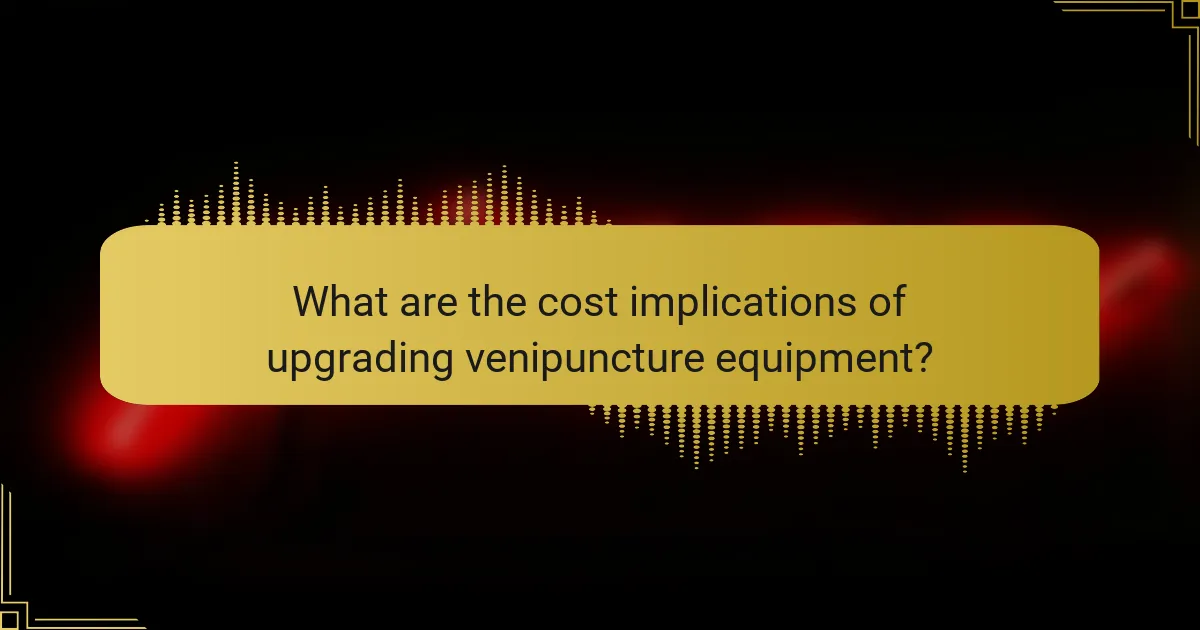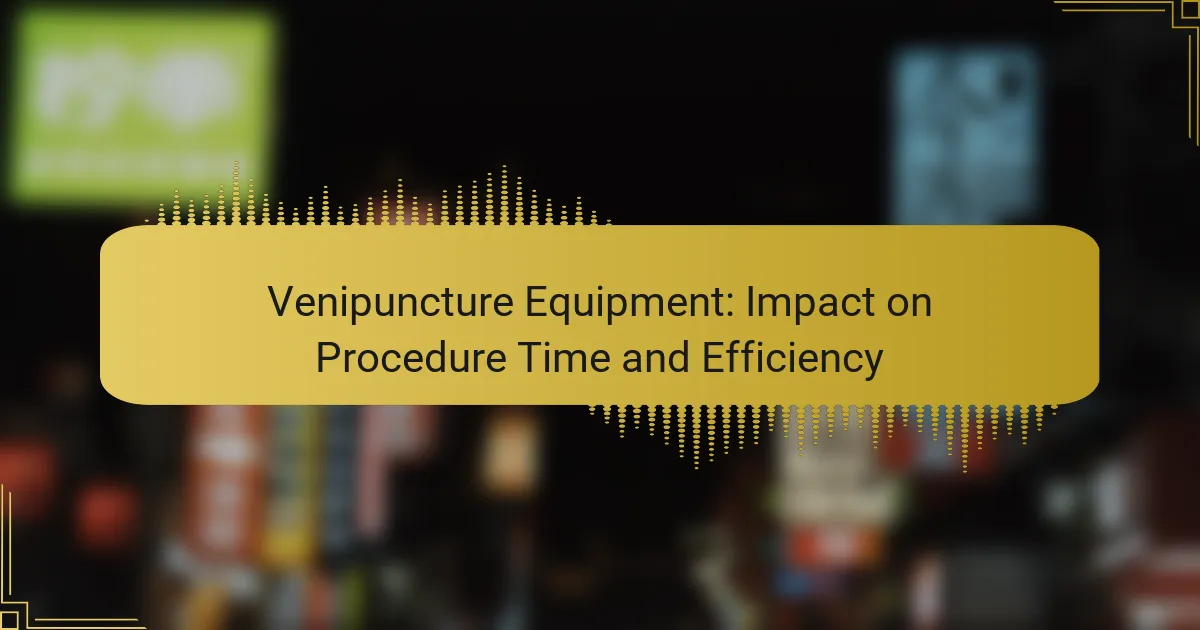Venipuncture equipment plays a crucial role in enhancing the efficiency and speed of blood collection procedures. By utilizing advanced tools such as vacutainer systems and butterfly needles, healthcare providers can minimize setup times and complications, ultimately improving patient care and workflow in clinical settings.

How does venipuncture equipment affect procedure time in Canada?
Venipuncture equipment significantly impacts procedure time in Canada by streamlining the process, reducing setup durations, and minimizing complications. Efficient tools can lead to quicker blood draws, enhancing overall patient care and throughput in healthcare settings.
Reduced setup time
Modern venipuncture equipment is designed for quick assembly and ease of use, which reduces the time needed for setup. For instance, pre-packaged kits that include all necessary items—needles, tubes, and antiseptics—allow healthcare professionals to prepare faster. This efficiency can cut setup time by several minutes, which accumulates in busy clinics.
To maximize efficiency, healthcare providers should ensure that all equipment is organized and easily accessible. Regular audits of supplies can help maintain optimal readiness, preventing delays during patient appointments.
Fewer complications
Using high-quality venipuncture equipment can lead to fewer complications, such as hematomas or infections, which often require additional time for management. For example, safety-engineered needles reduce the risk of needlestick injuries, thereby minimizing the need for follow-up procedures. This reduction in complications can save healthcare providers significant time and resources.
Training staff on the proper use of equipment is essential to further decrease complications. Regular training sessions can help ensure that all personnel are familiar with the latest tools and techniques, leading to smoother operations.
Improved patient flow
Efficient venipuncture equipment enhances patient flow by allowing for quicker blood draws, which can lead to shorter wait times. When procedures are performed swiftly, patients can move through the system more effectively, improving overall satisfaction. For instance, using automated blood collection devices can significantly speed up the process.
To improve patient flow, healthcare facilities should consider implementing a streamlined scheduling system that accounts for the efficiency of their venipuncture equipment. This approach can help balance patient load and ensure that resources are utilized effectively, ultimately enhancing the patient experience.

What types of venipuncture equipment enhance efficiency?
Efficient venipuncture equipment can significantly reduce procedure time and improve overall workflow in clinical settings. Key tools include vacutainer systems, butterfly needles, and automatic blood collection devices, each offering unique advantages for various situations.
Vacutainer systems
Vacutainer systems streamline the blood collection process by using pre-filled vacuum tubes that automatically draw blood. This method minimizes the risk of contamination and reduces the need for multiple punctures, enhancing efficiency.
When using vacutainer systems, ensure the correct tube type is selected based on the tests required. Familiarity with the color-coded tube system can help avoid errors and speed up the collection process.
Butterfly needles
Butterfly needles are designed for easier access to veins, especially in smaller or difficult-to-puncture veins. Their flexible wings provide better control and stability during the procedure, which can lead to quicker and more successful blood draws.
Consider using butterfly needles for pediatric patients or those with challenging venous access. However, be aware that they may be less efficient for larger volume collections compared to vacutainer systems.
Automatic blood collection devices
Automatic blood collection devices offer a hands-free approach to venipuncture, significantly reducing the time spent on blood draws. These devices can be programmed for specific protocols, ensuring consistency and precision in sample collection.
While automatic devices can enhance efficiency, they require proper training and maintenance to ensure reliability. Evaluate the cost versus the time savings in your clinical setting to determine if they are a worthwhile investment.

What are the key features of efficient venipuncture equipment?
Efficient venipuncture equipment is designed to streamline the blood collection process, reducing procedure time and enhancing overall efficiency. Key features include ergonomic design, integrated safety mechanisms, and compatibility with various tubes, all of which contribute to a smoother experience for both healthcare providers and patients.
Ergonomic design
An ergonomic design in venipuncture equipment minimizes strain on the healthcare provider while maximizing comfort for the patient. Features such as contoured grips and adjustable components allow for better handling and positioning during the procedure.
For example, devices with a lightweight structure and balanced weight distribution can significantly reduce fatigue during prolonged use. This design consideration can lead to quicker, more precise blood draws, ultimately improving patient throughput.
Integrated safety mechanisms
Integrated safety mechanisms are crucial for reducing the risk of needlestick injuries and ensuring compliance with health regulations. Equipment that includes features like retractable needles or safety shields helps protect both the patient and the healthcare worker.
These safety features can also streamline the disposal process, as many devices are designed for easy, single-handed activation. This not only saves time but also minimizes the potential for accidents during the procedure.
Compatibility with various tubes
Compatibility with various blood collection tubes is essential for efficient venipuncture. Equipment that accommodates different tube types and sizes allows for flexibility in testing and reduces the need for multiple devices during a single procedure.
Healthcare providers should consider using equipment that can easily switch between tube types, such as those with color-coded adapters. This feature can significantly decrease the time spent on blood collection, as it eliminates the need for additional handling or adjustments.

How do training and protocols impact venipuncture efficiency?
Training and established protocols significantly enhance venipuncture efficiency by ensuring that healthcare professionals perform the procedure consistently and correctly. Well-defined guidelines and regular skill refreshers lead to reduced procedure times and improved patient outcomes.
Standardized procedures
Standardized procedures streamline the venipuncture process by providing clear, step-by-step instructions that all practitioners can follow. This consistency minimizes variability in technique, which can lead to fewer complications and faster completion times. For example, using a uniform approach for site selection and needle insertion can reduce the average procedure time by several minutes.
Implementing standardized protocols also facilitates better communication among team members, ensuring that everyone understands their roles during the procedure. This clarity helps to avoid delays caused by confusion or miscommunication.
Regular training sessions
Regular training sessions are essential for maintaining venipuncture skills and knowledge among healthcare professionals. These sessions can include hands-on practice, updates on best practices, and reviews of new techniques or equipment. Frequent training helps reinforce skills, which can lead to quicker and more efficient procedures.
Additionally, ongoing education can address common pitfalls, such as improper needle handling or inadequate patient preparation, which can prolong the venipuncture process. By identifying and correcting these issues through training, efficiency can be significantly improved.
Use of simulation technology
Simulation technology offers a valuable tool for enhancing venipuncture training without the risks associated with practicing on live patients. High-fidelity simulators allow practitioners to refine their techniques in a controlled environment, leading to increased confidence and skill proficiency. This practice can translate to faster and more accurate procedures in real-life scenarios.
Moreover, simulation can provide immediate feedback, helping practitioners to identify areas for improvement. By incorporating simulation into regular training, healthcare facilities can ensure that their staff remains adept at performing venipuncture efficiently and effectively.

What are the cost implications of upgrading venipuncture equipment?
Upgrading venipuncture equipment can have significant cost implications, both in terms of initial investment and long-term savings. While the upfront costs may be substantial, the efficiency gains and reduced supply expenses can lead to overall financial benefits.
Initial investment costs
The initial investment for modern venipuncture equipment can vary widely, typically ranging from several hundred to several thousand dollars. Factors influencing this cost include the type of equipment, brand, and features such as automation and safety mechanisms. It’s essential to evaluate the potential return on investment by considering the expected improvements in procedure efficiency.
When budgeting for new equipment, consider not only the purchase price but also installation and training costs. Allocating funds for these additional expenses can help ensure a smooth transition to the upgraded system.
Long-term savings on supplies
Upgrading venipuncture equipment often leads to long-term savings on supplies. Newer devices may use fewer consumables or more efficient materials, reducing overall supply costs. For instance, automated systems can minimize the need for multiple needles or tubes, leading to lower expenditures over time.
Additionally, modern equipment may enhance the accuracy of procedures, decreasing the likelihood of errors that require additional supplies or retesting. This efficiency can translate into significant savings, particularly in high-volume settings.
Impact on staffing needs
Upgrading venipuncture equipment can affect staffing needs by potentially reducing the number of personnel required for procedures. Advanced systems may automate certain tasks, allowing existing staff to focus on more complex duties or patient care. This shift can lead to a more efficient use of human resources.
However, it’s crucial to consider the training requirements for staff to effectively use new equipment. Investing in proper training can maximize the benefits of the upgrade and ensure that staff are comfortable and proficient with the new technology.

What are the emerging trends in venipuncture technology?
Emerging trends in venipuncture technology focus on enhancing efficiency and accuracy during blood collection procedures. Innovations such as smart devices, telemedicine integration, and AI-assisted techniques are transforming traditional practices, leading to quicker and more reliable outcomes.
Smart venipuncture devices
Smart venipuncture devices utilize advanced sensors and connectivity features to improve the accuracy of needle placement. These devices often provide real-time feedback to healthcare professionals, reducing the likelihood of multiple attempts and minimizing patient discomfort.
Examples include devices that use infrared light to locate veins or those equipped with augmented reality to guide the user. By streamlining the venipuncture process, these smart devices can significantly decrease procedure time, often reducing it to just a few minutes.
Telemedicine integration
Telemedicine integration in venipuncture allows healthcare providers to remotely guide patients through the blood collection process. This trend is particularly useful in home healthcare settings, where patients may require assistance without direct supervision from a clinician.
Using video consultations, healthcare professionals can instruct patients on proper techniques and ensure that the procedure is performed correctly. This approach not only enhances patient engagement but also optimizes the use of healthcare resources, potentially reducing overall costs.
AI-assisted techniques
AI-assisted techniques in venipuncture involve the use of machine learning algorithms to predict the best sites for needle insertion. These systems analyze patient data, such as age, body mass index, and previous venipuncture history, to recommend optimal approaches.
By leveraging AI, healthcare providers can improve first-attempt success rates, which can be crucial in emergency situations. Additionally, these techniques can help in training new staff by providing data-driven insights into best practices, ultimately enhancing the overall efficiency of blood collection procedures.
